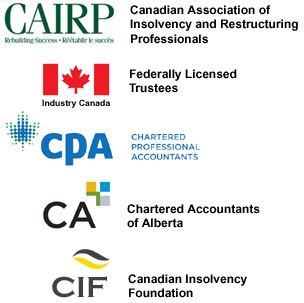There are no set terms in a proposal, and we often refer to proposals as being a case of “Let’s Make a Deal”. Although many proposals contain the same basic terms, there are no restrictions as to what you can offer or include in a proposal.
All proposals, in one form or another, offer the payment of money or cash equivalents. Some examples of proposals handled by our firm would be as follows:
The Standard Form Proposal:
A fixed monthly payment for a fixed number of months, for example, $600.00 a month for 60 months, or $36,000.00. The payment amount and payment term offered in your proposal are based on your personal budget, taking into account what you would be required to pay in a bankruptcy. This is the most common type of proposal.
Variable Proposal:
Sometimes people’s earnings are seasonal, and vary throughout the year. If you know with reasonable confidence when your income goes up and when it goes down, you can take advantage of variable payments, for example, $500 a month from May to October, and $300/month from November to April. The timing of the higher and lower payments depends largely on the job you have. For instance, if you are a greenskeeper at a golf course, your income is highest in the summer, but if you work as an ice rink superintendent, your income is probably highest in the winter. The important point to note in a proposal is that the payment variations can be tailored to suit you and your situation.
Proposal with Increasing Payments:
Individuals may have a temporary setback in income, such as a temporary layoff, or be off work due to an injury, and may be on short term disability. In cases such as these, you may ask to start off with a lower payment for the first six months, increasing the payment when you get back to work. This can also be beneficial if you are earning the same income, but need some extra funds to catch up on your mortgage payments or catch up on a second loan where you are at risk of losing a car or assets.
Proposal With Decreasing Payments:
Individuals may be working two jobs or approaching retirement, where a portion of their future income will be disappearing, and they will not be able to make the same payment over an extended period of years. In cases such as these, you may start your proposal off with a larger payment, and reduce it when your pension kicks in, or you can no longer continue working a second or part time job. For example, you may offer to pay $600 a month for the first three years of your proposal, reducing it to half of that, or $300 a month when you go on pension.
The Lump Sum Proposal:
Individuals may have a family member or have access to funds by cashing in an exempt life insurance policy or LIRA, etc., etc., that will allow then to make a one-time lump sum proposal payment to
their creditors. You might say, “If I could make a lump sum payment, I would have paid my creditors!”
In a lump sum situation, you may not be able to assemble enough funds to pay your entire debt. This option allows you to make an offer which does not represent payment of your full debt, and you offer might equate to only 50%, 75%, etc., of the total when taken as a percentage of our debts.
Liquidation Proposal:
“Sell or Liquidate an Exempt Asset”: This is very similar to a lump sum proposal, only that you are agreeing to surrender or sell an asset which is otherwise exempt in a bankruptcy. An example of such a proposal might include listing your home for sale, making nominal monthly payments of $100 – $200 a month until the house is sold, and the proceeds are paid into your proposal estate. This option is not limited to home owners, but can apply equally to any exempt property you may have including an RRSP or Whole Life Insurance Policy, with a cash surrender value or loan value.
Convert from a Bankruptcy:
Sometimes people file an assignment in bankruptcy and their circumstances change so significantly that they find themselves having to pay large or significant monthly payments on that income. As an alternative to continuing with the bankruptcy, you can file a proposal with your Trustee out of bankruptcy, where you agree to pay a smaller amount each month for a longer period of time and keep more money each month. The creditors benefit by your proposal because you are agreeing to pay more, and you benefit because the proposal will allow you to make more manageable payments and improve your lifestyle.
The drawback to this option is that you must agree to pay your creditors more than they would receive in the bankruptcy, in order to encourage them to accept your proposal out of bankruptcy.
People whose jobs depend on being out of bankruptcy by a certain time, often elect to proceed with his option. To create an incentive for your creditors to vote in favour of the conversion, the proposal out of bankruptcy and the added payments have to be perceived as being worthwhile to your creditors.
Example: Let’s say your circumstances change, and you find yourself owing surplus income of $900.00 per month and your bankruptcy will run 21 months, such that you will end up paying $18,900.00, but you just can’t make the $900 payment each month. As an alternative, you may offer a proposal to pay your creditors $500.00/month for 48 months or $24,000.00. The added sum compensates the creditors for the time value of money received over a longer period and allows you to put $400.00 back into your monthly budget. If your creditors accept this type of proposal, your bankruptcy is annulled, or cancelled, and you move forward as if you had always filed a proposal.
Creditors often ask that you post security, such as a lien on your home or car for surety of performance of the proposal by you.
We have considerable experience in dealing with creditors, and we specialize in tailoring proposals to fit an individual’s specific needs. We want to ensure that any payment plan you are committing to is not so onerous or difficult for you, that it leads to an inability to complete the proposal.
In order for any proposal you consider to be successful, it should provide you with a little money left over for you to reward yourself once and a while, even it is just a little bit. One of our Licensed Trustees would be happy to sit down with you and help you draft a proposal. So please do not hesitate to contact us.



